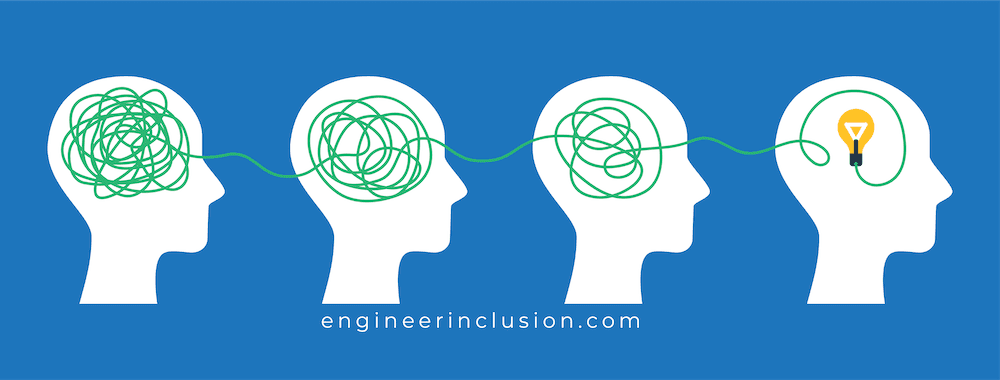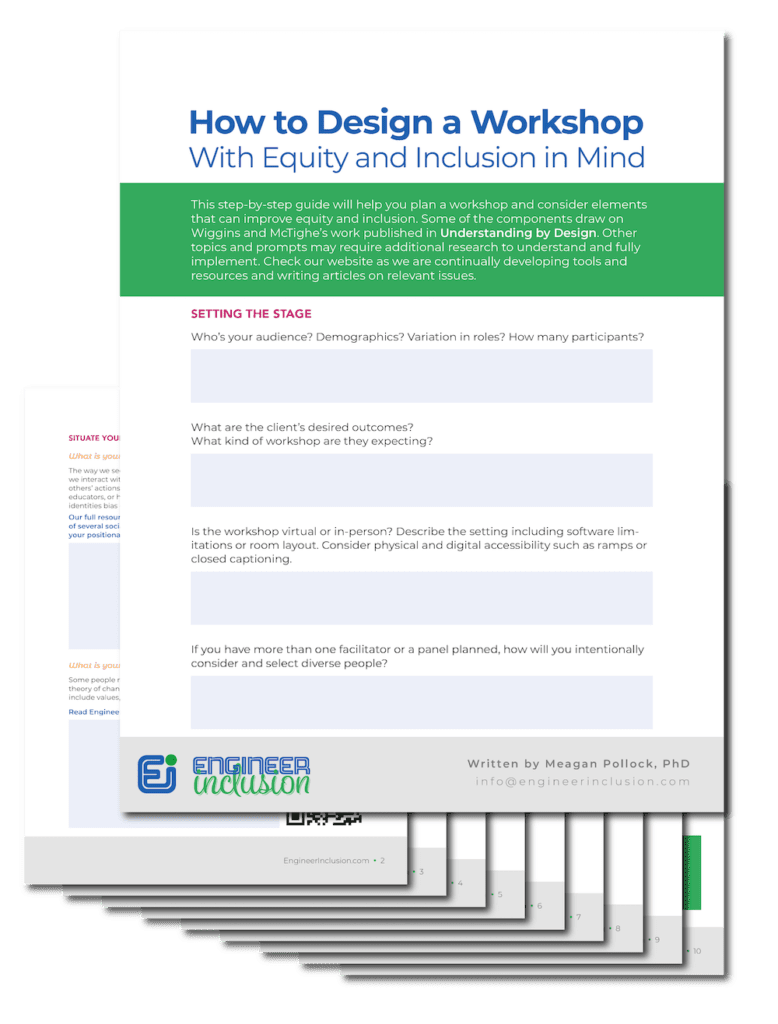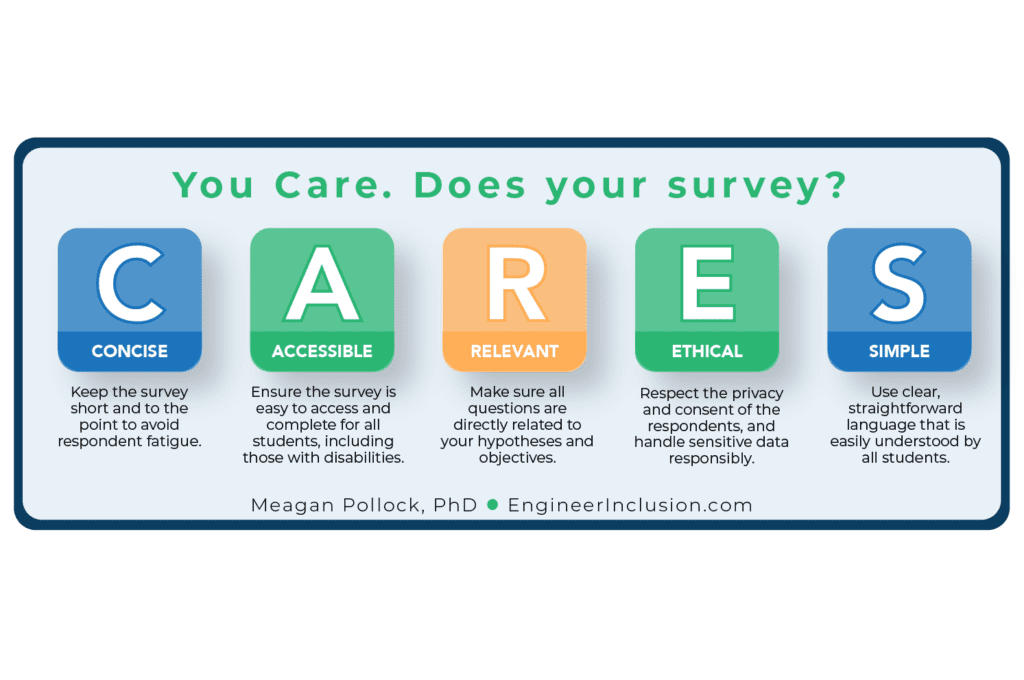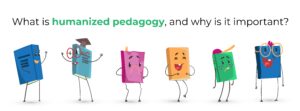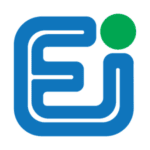Creating an effective and engaging workshop that prioritizes equity and inclusion requires thoughtful preparation and a strategic approach. Drawing on over a decade of experience, our 40-minute webinar offers a wealth of insights into designing workshops with an equity and inclusion lens. By following our step-by-step guide, complete with an easy-to-use worksheet, you’ll be equipped to design workshops that not only engage your audience but also foster an inclusive environment, regardless of the content area.

This step-by-step guide will help you plan a workshop and consider elements that can improve equity and inclusion.
Watch a 40m recorded webinar, and download a companion worksheet to guide you step-by-step to design an engaging and effective workshop with equity and inclusion in mind.
Objectives

Introduce a design method for creating an effective and engaging workshop.

Show you how to clarify and prioritize content for a workshop.
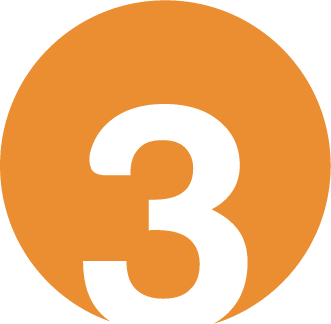
Offer recommendations for engaging instructional strategies.

Leave you with tips for instructional choices and styles.
Webinar
Watch this 40-minute recorded webinar on how to design a workshop with equity and inclusion in mind and download the companion guide below.
We can deliver this workshop to your team.
Contact us to learn more.
Designing an Effective and Engaging Workshop
Creating an effective and engaging workshop that prioritizes equity and inclusion requires thoughtful preparation and a strategic approach. Drawing on over a decade of experience, our 40-minute webinar offers a wealth of insights into designing workshops with an equity and inclusion lens. By following our step-by-step guide, complete with an easy-to-use worksheet, you’ll be equipped to design workshops that not only engage your audience but also foster an inclusive environment, regardless of the content area.
Setting the Stage
Before diving into workshop content, it’s essential to understand your audience. Assessing participant demographics, roles, and the expected number of attendees will inform your content and delivery methods, ensuring relevance and engagement. Additionally, identifying the client’s desired outcomes helps tailor the workshop’s objectives and structure. Whether your workshop is virtual or in-person, considering the setting—including software limitations, room layout, and accessibility features like ramps or closed captioning—is crucial for inclusivity. When planning for multiple facilitators or a panel, intentionally selecting diverse individuals enriches the workshop’s perspective, promoting a broader and more inclusive dialogue.
Download the handout below for prompts.
Situate Yourself and Your Teaching Philosophy
Your unique perspective and teaching philosophy significantly influence the workshop environment. Reflecting on your positionality—how your identities and experiences shape your worldview—can enhance your ability to lead with equity and inclusion. This self-awareness is vital for educators and leaders aiming to create inclusive spaces. Furthermore, clearly articulating your theory of change, which encompasses your values, goals, and intentions, provides a solid foundation for your teaching approach. This reflection ensures that your workshop is not only informative but transformative, fostering a deeper connection with your participants.
Stages of Backward Design
Adopting the Backward Design framework facilitates a focused and outcome-based workshop planning process. Begin by establishing the desired outcomes: what understandings or skills should participants leave with? Setting clear learning objectives, anticipating misconceptions, and identifying evidence of learning guide the development of meaningful and inclusive learning experiences. This methodical approach ensures that your workshop content and activities are aligned with your goals, catering to the diverse needs and backgrounds of your participants.
Download the handout below for prompts.
Prioritize Content
Effective content prioritization prevents cognitive overload and enhances the learning experience. Distinguishing between “Important to Know and Do” and “Worth being Familiar With” helps focus on the core ideas and skills, ensuring participants engage deeply with the most crucial aspects of your workshop. This careful selection of content supports a paced and comprehensive exploration of topics, avoiding rushed activities and fostering a more impactful learning journey.
Instructional Strategies
Implementing student-centered instructional strategies can significantly bolster equity and inclusion in your workshop. Techniques like Round Robin, Constructivist Listening, Think-Pair-Share, Jigsaw, and Gallery Walks promote active participation and ensure diverse voices are heard. These strategies not only facilitate creativity and innovation but also build a sense of community among participants, making the learning experience more inclusive and enriching.
See table below and download the handout to learn more!
Instructional Styles & Choices
Your instructional style profoundly impacts the learning environment. Emphasizing a student-centered approach, practicing active and empathic listening, and adopting an asset-mindset highlight the strengths and potential of all participants. Additionally, focusing on cultural responsiveness and coaching rather than instructing fosters an atmosphere of support and empowerment, enabling each participant to feel valued and understood.
Download the handout below for prompts.
Learning Environment
The learning environment encompasses all aspects that contribute to the workshop’s overall atmosphere. It’s crucial to establish clear group norms and agreements, especially in longer-term engagements, to create a foundation of respect and cooperation. Remembering to set and honor breaks, providing clear and detailed instructions, and ensuring accessibility in all aspects of the workshop are essential for maintaining an inclusive and engaging learning space. Paying attention to the culture and climate of your workshop, and ensuring it supports diverse ways of knowing and learning, is vital for fostering an environment where every participant feels respected and included.
Download the handout below for tips.
Put it into practice
By carefully integrating these strategies and insights, you can design workshops that not only educate but also empower participants in a truly inclusive and equitable manner. Remember, the success of a workshop lies not just in the content delivered, but in how it’s delivered and how participants are engaged and valued throughout the process. We encourage you to dive deeper into these concepts by watching our detailed 40-minute webinar, where we share years of expertise in crafting workshops with equity and inclusion at their heart. To further assist your planning process, download our step-by-step guide available in a user-friendly worksheet format. These resources are designed to provide you with a comprehensive framework, empowering you to create impactful and transformative learning experiences for all participants. Let’s work together to make education more inclusive, one workshop at a time.
Instructional Strategies
The following strategies are student-centered examples shared in the webinar that improve equity and inclusion if done correctly. Download the handout for a list of the definitions.
Round Robin | Round-robin brainstorming ensures everyone is involved; all ideas are shared, fostering greater creativity, innovation, and inclusion. |
Constructivist Listening | Constructivist listening is a facilitation strategy designed to foster a safe space for people to speak authentically about their feelings and beliefs. |
Think-Pair-Share | Think-pair-share is a collaborative teaching strategy used to help participants form individual ideas, discuss and share 1-1 with the others. |
Jigsaw | Jigsaw is a collaborative teaching strategy where participants from a home group split up to join a topic-focused group. Upon returning to the homegroup, each participant teaches about the topic they learned and discussed. |
Gallery Walks | Individuals or small groups create a poster or text or images about their topic or discussion and display it. Then everyone rotates in their original groups to read and learn from the artifacts. |
Case Studies | Case studies are stories used as a teaching tool to show applying a theory or concept to real situations. |
Perspective Taking | Perspective-taking refers to a person’s ability to consider a situation from a different point of view. Perspective-taking is a valuable tool in combination with case studies to encourage participants to practice empathy and understanding. |
Fishbowl | A fishbowl exercise is when a small group of participants has a discussion, and the remainder of the participants listen and take notes. The activity is best done with an inner and outer circle so that people can hear and see. A fishbowl is a demonstration to initiate another type of small group collaboration. |
Panel Discussion | A panel discussion is when a moderator leads a conversation between a small group of people. The audience observes and asks questions. The best panel discussions are interactive and responsive to the audience. |
Four Corners | In a four-corner exercise, you place four statements around the room or similarly in a remote configuration. Participants express their opinion or response by standing in front of one of four statements and then talking to others about why they have chosen their corner.
|
